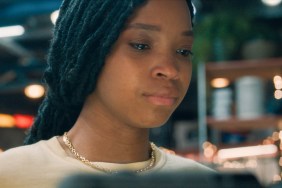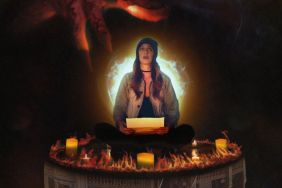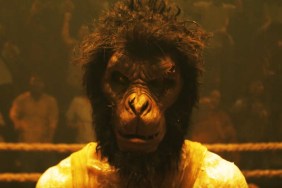There’s a good reason why Olivier Assayas is one of my favorite French filmmakers. Partially, it’s because he has never made the same movie twice while he always seems to be veering away from his fellow country men to do things that are edgy and modern and different, whether it’s Irma Vep and Clean or the craziness of Demonlover.
Following the 5 ½ hour Golden Globe-winning epic Carlos, Assayas is back with Something in the Air (Apres mai), a coming-of-age tale set in the early ’70s that’s a surprisingly fitting follow-up to a mini-series about a terrorist, this time making his most personal and autobiographical film to date as well as his most youthful.
The film follows Gilles, an ambitious shaggy-haired high school student played by newcomer Clément Métayer, who could very well be seen as a younger version of Assayas himself, as he gets involved with a group of protesters performing acts similar to the Weather Underground in the States fighting against the war and police brutality. After an incident, Gilles leaves France for Italy where he gets involved with a group of artists and a beautiful free-spirited girl named Christine (Lola Créton). As he tries to find his own identity in the group, he discovers a love for filmmaking.
Working with mainly young first-time actors, Assayas has created a film that puts you firmly into those times and gives you the feeling of revolution felt by the youth back then. If you’re young and not sure of your future, Something in the Air is quite an inspirational film to see how French youth nearly forty years ago were going through similar things only during more difficult political times. It’s an artie film for sure, but it also features an even more amazing and eclectic soundtrack than Carlos if that’s humanly possible.
Something in the Air played the festival circuit last fall after premiering at Venice and ComingSoon.net caught up with Assayas at the New York Film Festival for our fourth interview with one of France’s hardest-to-label filmmaker.
ComingSoon.net: It’s interesting to see you do this after “Carlos.” It feels like a very fluid transition from a full-on revolutionary to these kids who are getting into the protests of the times. Was this something you wanted to do for a long time and it just happened that “Carlos” intersected with it?
Olivier Assayas: I suppose that it works in mysterious ways once in a while. It wasn’t the movie I planned to make really after “Carlos.” After I finished “Carlos” I wanted to work on a project that I had in the back of my mind for a while and I moved to the countryside so I can sit down and start writing and I took my stuff and notebooks and all. And I sat down and I opened my notebook and I realized that in the notebook I had started writing something else, a while back, like a couple years before and I started reading my notes, which actually dated from before “Carlos.” It kind of made sense. I liked what I read. It was still very basic, very sketchy and it was like more or less tat companion piece to my earlier film called “Water.” It’s a project I’ve always had in the back of my mind, and I did not remember that I had sat down to give some kind of shape to it but when I rediscovered it, I felt there was a movie there Instead of writing whatever I wanted to write, I just picked up where I had stopped and tried to develop it and see if it stuck, and it did.
The reason why I was interested and the reason why it felt relevant and felt like the right time to work on that is because it was dealing with the 1970s but in a completely different perspective. After a movie like “Carlos” which is a deconstruction of 1970s politics, it was really about putting them in the perspective of the end of the Cold War, it was about secret service warfare and blah, blah. I thought also about the dark side of the 1970s. I thought it was relevant to make a movie which was about youthful idealism, or more accurately, about my own way of surviving the 1970s.

CS: People must ask you about this, but the movie seems very autobiographical and that Gilles is supposed to be a version of you in some ways.
Assayas: Oh, yes, yes. The way I built the film was by using almost exclusively autobiographical elements, which I then slightly distorted or slightly adapted because it’s a movie and I’m trying to tell a story, but it’s the process of writing the film in the first place was pretty much about understanding that autobiography in that context and trying to deal with the 1970s, meant not only dealing with what I did but also dealing with what I did not do, meaning representing the other possibilities, the path followed by his friends. Ultimately it’s the same for every kid that age. You’re defined not just by what you do, but you’re also defined by the choices you have made not to follow this or that other path. So somehow I realized it was not just going to be an autobiography, it’s going to be a collected story of the 1970s where my own story would somehow be inscribed also in its singularity its weirdness.
CS: So all of the characters are versions of you in some ways?
Assayas: Well, usually in my movies I’m everywhere, part of me is here and there. In this film I’m pretty much Gilles and the other characters are just slightly different from me.
CS: Is your writing process completely separate from making movies where there’s no overlap, so that you make a movie, finish it and then you’re writing the next one?
Assayas: Well I like the rhythm. I like the notion of just making a film that involves struggling in the real world, to somehow create something out of resisting reality. After that, you go back to the quietness of just facing the white piece of paper and imagining something. It forces you to go a little further into yourself, just get something genuine out. Which can be painful, because as uch as filmmaking is addictive, writing is not addicted. I don’t think writing is addictive. It’s tougher. When you’re directing, you’re carried by the energy of putting the film into motion and it’s just like this big machine that drags you, carries you, so once it starts rolling, it’s essentially about getting it right, so there’s the fears and excitement involved but in terms of writing, writing can be a painful process. It’s a difficult process, but it’s essential. I mean, I love writing, don’t get me wrong, but it’s harder on me.
CS: Because you’re literally starting from scratch each time.
Assayas: Yes, yes.
CS: It’s interesting that your work has gotten more reflective over the past few years. I remember you made movies like “Demonlover” and “Irma Vep,” very edgy and set in the present day, so it’s interesting to see you doing these period pieces that are reflective of the past. Is that a factor of getting older and feeling more nostalgic?
Assayas: Hmm
no, it’s really about experimenting, it’s about experimenting in new things. What was fascinating for me about “Carlos,” beyond the many complex aspects of the film, is to try to make a film based on documented evidence. Instead of writing scenes… finding scenes in books and try to reproduce actual history in terms of cinema, which I found to be a fascinating challenge. To me, when I’m making “Demonlover” I’m experimenting, when I’m making “Carlos” I’m experimenting or when I’m making “Something in the Air” I’m experimenting, except I’m experimenting in other areas. I’m experimenting in terms of beyond whatever I’m telling and what’s the good center of the film. I’m experimenting in terms of connecting specific autobiography with filmmaking. This is really the closest I ever was to straight-forward autobiography.
CS: This is also the first time you’ve worked with all young actors and many non-actors, so what was the challenge there?
Assayas: I did it more or less in “Cold Water” although there were more grown-ups in “Cold Water.”
CS: That’s one of the few movies you’ve directed that I haven’t seen.
Assayas: It’s hard to see but I used the same names. It’s the two characters from “Cold Water” which I used initially when I was structuring the story of “Something in the Air”–it’s Gilles and Christine both times–but it was on a much smaller scale. In “Something in the Air” it’s non-professional actors who have the main parts and they have fairly difficult scenes and it’s a fairly complex movie completely realized on their skills, so it’s kind of scary and that’s also what was exciting about it for me. I suppose it also was made possible by “Carlos” because when I made “Carlos,” I used so many different types of actors, guys coming from completely different cultures, who spoke a language that was not their mother tongue, who had completely different culture. I was mixing absolute non-professionals with actors and it worked, so I thought, “Why not try and use completely new faces and actors who are completely virgins, who had never seen a camera before?” except Lola, who had been in movies obviously before but she was the only professional.

CS: How did you go about casting them? Did you just talk to a lot of different young people?
Assayas: I talked to them. I usually never do this but in the case of “Something in the Air” I did tests. I wrote a couple of scenes which I then worked on with them. It was pretty much about making sure they’re not scared of the camera, that they’re not frozen in front of the camera. To make sure they at least had the basic instincts of acting. But then of course, when I made the first tests with Clément, he could hardly speak because he was so intimidated.
CS: Is that something that you can use for his character?
Assayas: Yeah, I kind of trusted him. I liked him. I liked the guy. I thought he had the sensibility of the part and I was sure that he would overcome his shyness and his fear, but again, the tests were disastrous.
CS: Do you have financing people you have to convince of this casting?
Assayas: Yes, yes, of course, of course, but they somehow trust me. They also trust me because once they’ve accepted the notion that there’s no star in the film, they don’t care about that much who I would choose. They all accept my choices.
CS: I thought the American actress (India Salvor Menuez) was fantastic. I was reading a bit of her bio and was surprised to read that she’d actually done experimental films. It’s amazing to watch these kids now doing some of the same things you guys did in the ’70s.
Assayas: Well, yes, but I also picked individuals who had somewhat of the spirit of the 1970s, because when I was casting, I met so many great kids who had great potential as actors, but who felt too much like today, who had the way of speaking and an energy that is very typical of today whereas I was really looking for character who could embody something of the spirit of the 1970s and in the process, I understood that ultimately what I was looking for was aspiring artists. And in the end, I think I only picked Gilles for artistic inspiration–they wanted to be musicians, filmmakers, painters, whatever. They’re creative, so they understood. It was very difficult to share with them what the ’70s were politically right. Even now, I don’t think they fully grasp it but at least they understand through their own artistic vocation, they understand a little bit what was at the core of the film.
CS: Even though it’s been 40 years since the ’70s, do you feel that artistic inspiration is the one thing that’s carried through and remained constant?
Assayas: It’s at least at the very early age, it gives you a very precise notion of what becoming yourself is about, meaning that I’m telling a story that is very specific of the 1970s, but whatever is universal in it is that you always grow up being part of a generation, part of a group and immersed in the values of your generation and you become yourself when you break with those values. When you have any kind of artistic vocation, it’s pretty much about going off on the very specific single path which quickly drifts away from the values of your friends and your group.
CS: I was thinking of movies like “Before Sunset” and “The Barbarian Invasions” and do you think these might be characters you might want to revisit in ten years and see what they’d been up to since the end of the movie?
Assayas: Yeah, it crossed my mind. I don’t know what will come of it, but yes, it did cross my mind.

CS: I also loved the music you used and music generally plays a large part in all your movies, including “Carlos”
Assayas: Yea, but in different ways. Because as much as the music in “Carlos” was from another era, and it kind of worked in the conflict between the images and the period and the actual music. It gave the narrative this kind of energy and electricity. Here, it’s more like the songs come out for me as time capsules. It’s really the music I was actually listening to when I was going through exactly those emotions, those situations, so the movie, the image, the texture, it’s just completely one thing, much more than any one movie I made.
CS: Was the music part of the writing process where you were noting songs you’d need to use?
Assayas: No, it was not, but it’s the music that’s been the soundtrack of those years for me. It’s the actual records I was listening to. I wasn’t sure if they would make it to the final cut of the film but when I started editing and I tried the songs, it was just a perfect fit, and there was an obviousness to it that never really happened to me in another movie before that.
CS: A lot of times when directors make period pieces, the music seems forced, but this didn’t seem that way at all as if you were listening to the music while writing.
Assayas: Yes, because it’s not like the best of the 1970s, it’s pretty much the opposite, it’s really the most most obscure tracks of the period. I’m not talking Nick Drake or Syd Barrett but the Amazing Blondelle or Dr. Strangely Strange–very few people listen to that.
CS: When we see the album covers in the movie are those your actual album covers.
Assayas: No, they’re not my actual collection but they’re really the albums I had at that time. That’s the stuff I listened to.
CS: I was going to say that that’s a great record collection. I have’t seen some of those albums in a long time.
Assayas: Well, actually my brother has them. We have a good record collection in common and he kept them.
CS: Another thing that really stuck out for me is the scene at Pinewood Studios. I’ve been there many times over the years so I was surprised to see that. Did you actually shoot there?
Assayas: Yeah, we shot the exteriors at Pinewood. The interiors we shot in Paris.
CS: Can you talk about what was involved with shooting there and was that a real movie that was shot at Pinewood?
Assayas: Yeah, yeah, it’s inspired by the work of Kevin Connor. He was making those kinds of movies at the time. He was making movies like “The Land That Time Forgot” which is what I based it upon. It’s inspired by the spirit of the work of Kevin Connor.
CS: Any idea what you want to do next? This movie you finished to screen at Cannes?
Assayas: Yeah, we finished it in like June/July so I kind of sat on it all summer until Venice, but the next film I will hopefully shoot in the spring. I wrote it for Juliette Binoche, it’s a movie I wanted to make for a while. We wanted to work together for a while and I’ve been developing this for a while, so it’s kind of ready.
Something in the Air opens in New York at the IFC Center and Lincoln Plaza Cinemas today.









